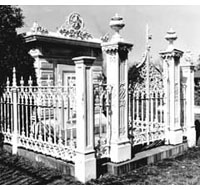NOMMA News & Events

Nov. 6 & 7, Hyatt Regency O’Hare, Chicago, Illinois
Space is filling up fast! Only 2 - $100 FabCAD discounts left!
Incorporating CAD into Your Daily Operations
Presenters: Dave Filippi, FabCAD, Inc. & Mark O’Malley, O’Malley Welding & Fabricating Inc.
Dates: November 6, 12:00 – 5:00 p.m., November 7, 8:00 a.m. – 2:00 p.m.
Location: Hyatt Regency O’Hare, Chicago, Illinois
This seminar is designed for fabricators who are either currently looking into adding CAD to their operations or who have CAD but have not fully leveraged this technology.
- Using CAD at the initial sales call and/or bid process.
- Taking job photos and showing the design in the photo (eliminate the phrase "I didn’t think it was going to look like this.").
- Using CAD to simplify field measuring.
- Using CAD for estimating residential and commercial work.
- Using CAD to submit jobs for approval using sheet templates and creating multi-sheet PDFs.
- Using CAD in the fabrication and installation process.
- Creating installation and shop detail drawings from field dimensions and/or customer PDFs.
- Drawing picket, pipe, glass, and cable railings. Level and slope.
- Laying out steel stairs both circular and straight.
- Drawing driveway and walk gates
- Creating a custom parts, bean and column library.
- Quality control tools to reduce or eliminate your "graveyard".
- Simulating installations shop layouts using CAD.
- Where to learn more.
Cost: $350 NOMMA members/ $450 nonmembers
Only Two $100 discount (given by FabCAD Inc.) left - sign up today – space is limited!
Your fee includes class materials, lunch Saturday and breaks. You can use this registration form or register online at www.nomma.org. Multiple attendees from the same company will receive a 10% discount.
Questions? Contact Martha Pennington (888-516-8585, ext. 104; martha@nomma.org)
Download Flier | Online Info
|
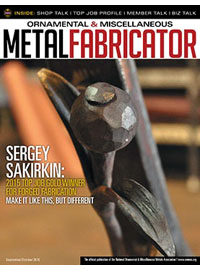 Have you seen the newly-redesigned O&MM Fabricator magazine? If you liked it, we know you'll be happy with NOMMA's newly-combined 2016 Membership Directory & Buyers' Guide. Have you seen the newly-redesigned O&MM Fabricator magazine? If you liked it, we know you'll be happy with NOMMA's newly-combined 2016 Membership Directory & Buyers' Guide.
Act now to secure your spot. Sales will be coming to a close tomorrow, Thursday, October 15. Placing an ad in this industry resource can be great exposure for you and your company. Please contact Beth Palmer at 352-333-3404 or email her at bpalmer@naylor.com for advertising opportunities.
|
Be sure to register for the industry event of the year!
The METALfab Annual Meeting will be held March 16 through March 19 in Greenville, South Carolina.
|
Member News
Please Log In to the MVS and Update Your Company's Listing Information Before October 28.
As a NOMMA member, you now have the opportunity to update your company's listing information using a unique username and password. The MVS is user-friendly and safe, and none of the information stored will be used for anything other than gathering information for the 2016 NOMMA Membership Directory & Buyers' Guide. With your help, your most up-to-date information will be included in this valuable member resource.
Please be sure to log in and update every field included in the MVS to ensure your listing is correct and complete. It will help us accurately showcase your information in this valuable, year-long publication.
By now, you should have received an email containing the link to the MVS portal as well as your unique username and password. If you are
a NOMMA member and have not received this email, please let Marbella Miller know by emailing her at marbella@naylor.com or calling her direct line: 352-333-3391.
|
If you do, please be sure to share this information with our new
NOMMA Editor-in-Chief, Marbella Miller. We love to feature news, updates, tips, etc. from our members and friends in the industry in both the O&MM Fabricator and in the NOMMA Newswire newsletter. You can reach Marbella directly by emailing her at marbella@naylor.com.
|
Featured Top Job Contest Winners
In order to be placed in this category, the majority of the stair needs to be of metal construction and installed in a commercial or public environment.
Gold Winner:
Heirloom Stair & Iron Inc.
Campobello, South Carolina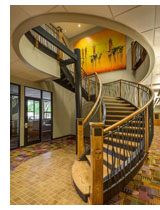
When Heirloom Stair & Iron Inc. first met with the architect, they were told that this stair was going to be the focal point of the entire building. The design was left up to Heirloom Stair & Iron Inc. The substructure was fabricated by rolling flat bar in a plate roller at an angle equal to the pitch of the stairs. Two plates for the outside radius and two for the inside radius. These were tack welded to a jig to form the beginnings of a box beam for each side. CNC plasma cutting was used to cut the 4" wide top and bottom to finish out the beams. Railings were made from different sizes of solid round bar textured with a power hammer to produce a very organic look. The original design called for the railings to be installed on top of the box beams. At the last minute, the school administrator decided that he wanted the rails to hang off the side in order to increase the width between the inside and outside rails. This increased the complexity of the rail install significantly. In addition to the railings, there were 50 feet of level rail around the balcony.
This project took approximately 640 hours of labor.
Visit Heirloom Stair & Iron Inc. on the web.
Silver Winner:
Couturier Iron Craft Inc.
Comstock Park, Missouri
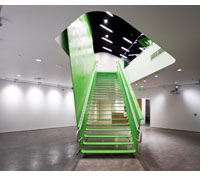 This stair project was designed to give the appearance of an open-air staircase hanging from the second-floor ceiling using 13 tons of steel plate. The soffit is the Shop fabrication to complete the entire assembly totaled 1,600 hours. facade and the facade is also the stair. The stair is hung from the second floor, bears lightly at the first floor and folds up into a green wall that is continuous to the second-floor ceiling. The staircase and wall were fabricated and formed using 3/4" thick A36 steel plate. Each stair tread was bent to a precise compound pitch and radius as to flow neatly into the stringers. The biggest structural challenge was satisfying the vibration and acceleration limits of the stair under foot traffic. This was achieved through the use of the structural engineer's own finite-element-analysis software. Due to the stair's deflection, the 3/8" glass risers could not span from tread to tread but instead had to cantilever from a single edge of each tread. The front of the building was disassembled for the stairs access, and the stair was installed as a single piece with the steel wall following. This stair project was designed to give the appearance of an open-air staircase hanging from the second-floor ceiling using 13 tons of steel plate. The soffit is the Shop fabrication to complete the entire assembly totaled 1,600 hours. facade and the facade is also the stair. The stair is hung from the second floor, bears lightly at the first floor and folds up into a green wall that is continuous to the second-floor ceiling. The staircase and wall were fabricated and formed using 3/4" thick A36 steel plate. Each stair tread was bent to a precise compound pitch and radius as to flow neatly into the stringers. The biggest structural challenge was satisfying the vibration and acceleration limits of the stair under foot traffic. This was achieved through the use of the structural engineer's own finite-element-analysis software. Due to the stair's deflection, the 3/8" glass risers could not span from tread to tread but instead had to cantilever from a single edge of each tread. The front of the building was disassembled for the stairs access, and the stair was installed as a single piece with the steel wall following.
Shop fabrication to complete the entire assembly totaled 1,600 hours.
Visit Couturier Iron Craft Inc. on the web.
Bronze Winner:
Custom Metals Inc.
Madison, Wisconsin
This monumental stair was inspired by horse racing: it features heavy guard rails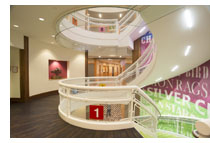 those that line a track, and panels like starting gates adorned with jockey numbers. It rises four stories to a lookout with a 360-degree view. Each flight differs from each other in terms of height, width, or interface with the building. The staircase is painted steel with an offset brushed stainless steel handrail. The engineer was concerned that the structure should be rigid, so he specified HSS 14 x 4 x 5/8" stringers, and top rails made from 3.5" XS pipe (.318" wall). With just those two elements, each linear foot of the staircase weighs over 160#. The staircase was fabricated in sections within Custom Metals Inc.'s shop—some segments nearly reached the shop ceiling. One of the biggest challenges was adjusting the radii of the stringers in small increments to correctly fit into the existing walls of the site. those that line a track, and panels like starting gates adorned with jockey numbers. It rises four stories to a lookout with a 360-degree view. Each flight differs from each other in terms of height, width, or interface with the building. The staircase is painted steel with an offset brushed stainless steel handrail. The engineer was concerned that the structure should be rigid, so he specified HSS 14 x 4 x 5/8" stringers, and top rails made from 3.5" XS pipe (.318" wall). With just those two elements, each linear foot of the staircase weighs over 160#. The staircase was fabricated in sections within Custom Metals Inc.'s shop—some segments nearly reached the shop ceiling. One of the biggest challenges was adjusting the radii of the stringers in small increments to correctly fit into the existing walls of the site.
This project took approximately 1,800 hours of labor.
Visit Custom Metals Inc. on the web.
|
Featured Stories
The preservation of cast-iron architectural elements, including entire facades, has gained increasing attention in recent years as commercial districts are recognized for their historic significance and revitalized. This Brief provides general guidance on approaches to the preservation and restoration of historic cast iron. Cast iron played a pre-eminent role in the industrial development of our country during the 19th century. Cast-iron machinery filled America's factories and made possible the growth of railroad transportation. Cast iron was used extensively in our cities for water systems and street lighting. As an architectural metal, it made possible bold new advances in architectural designs and building technology, while providing a richness in ornamentation.
Visit http://www.nps.gov/tps/how-to-preserve/briefs/27-cast-iron.htm to view the full article online.
|
|
This October, America will take a major step to mitigate fraud and improve our financial security by migrating away from outdated credit and debit cards that transmit sensitive customer data using magnetic stripes. In 2015, it should not surprise us that a system using essentially the same technology as cassette tapes is especially vulnerable. That is why major credit card companies, lenders, and businesses are now embracing new, more secure, authenticated payment technologies. Many consumers already have credit cards embedded with microchips in their wallets, and many more will be receiving these cards in the coming months. This technology – also known as EMV (Europay, Mastercard, Visa) – is a safer form of payment for buyers and sellers alike, as the cards are nearly impossible to counterfeit.
Visit https://www.sba.gov/blogs/make-switch-new-payments-technology to view the full article online.
|
NOMMA Career Center
Matt Burgess, CEO of Missouri Land Company has more than two decades of developing commercial and residential real estate. With a unique ability to bring people together for the advantage of all involved, Matt understands the benefits of collaboration. His extensive background in site development, land acquisition, land planning, construction, rental properties, and general contracting has driven exponential growth in communities throughout the U.S.
When baby boomers collaborate with millennials, Matt suggests the following:
- Communicate Preferences: At the start, convey your preferred method of communication. According to the Princeton Review, the awareness of preferred work styles is key to bridging generation gaps. Be clear about whether you are more likely to respond via phone, text, email, or face-to-face meeting. When communications preferences are known, less time is wasted waiting on responses.
- Awareness and Appreciation: Take the time to understand why each team member is involved in the development deal. This will make you acutely aware of each individual’s value, decrease frustration, and foster an environment of respect.
- Be Humble: Do not let ego and righteousness get in the way of progress. Respect each individual’s contributions.
- Build a Relationship: Invest the time to build a relationship with those involved in the deal away from the negotiation table and the project. When you begin to foster a more personal relationship with an individual (as opposed to building a relationship with the tasks for which the individual is responsible), you gain a broader perspective about their approach.
- Know When To Walk Away: Sometimes a deal goes south. It could have nothing to do with the personalities (or ages) of those involved, or it could have everything to do with those variables. A smart commercial development professional knows when to walk away in order to save time, money, and frustration.
|
|

 Have you seen the newly-redesigned O&MM Fabricator magazine? If you liked it, we know you'll be happy with NOMMA's newly-combined 2016 Membership Directory & Buyers' Guide.
Have you seen the newly-redesigned O&MM Fabricator magazine? If you liked it, we know you'll be happy with NOMMA's newly-combined 2016 Membership Directory & Buyers' Guide. 
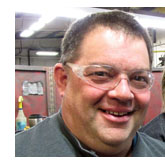

 This stair project was designed to give the appearance of an open-air staircase hanging from the second-floor ceiling using 13 tons of steel plate. The soffit is the Shop fabrication to complete the entire assembly totaled 1,600 hours. facade and the facade is also the stair. The stair is hung from the second floor, bears lightly at the first floor and folds up into a green wall that is continuous to the second-floor ceiling. The staircase and wall were fabricated and formed using 3/4" thick A36 steel plate. Each stair tread was bent to a precise compound pitch and radius as to flow neatly into the stringers. The biggest structural challenge was satisfying the vibration and acceleration limits of the stair under foot traffic. This was achieved through the use of the structural engineer's own finite-element-analysis software. Due to the stair's deflection, the 3/8" glass risers could not span from tread to tread but instead had to cantilever from a single edge of each tread. The front of the building was disassembled for the stairs access, and the stair was installed as a single piece with the steel wall following.
This stair project was designed to give the appearance of an open-air staircase hanging from the second-floor ceiling using 13 tons of steel plate. The soffit is the Shop fabrication to complete the entire assembly totaled 1,600 hours. facade and the facade is also the stair. The stair is hung from the second floor, bears lightly at the first floor and folds up into a green wall that is continuous to the second-floor ceiling. The staircase and wall were fabricated and formed using 3/4" thick A36 steel plate. Each stair tread was bent to a precise compound pitch and radius as to flow neatly into the stringers. The biggest structural challenge was satisfying the vibration and acceleration limits of the stair under foot traffic. This was achieved through the use of the structural engineer's own finite-element-analysis software. Due to the stair's deflection, the 3/8" glass risers could not span from tread to tread but instead had to cantilever from a single edge of each tread. The front of the building was disassembled for the stairs access, and the stair was installed as a single piece with the steel wall following. those that line a track, and panels like starting gates adorned with jockey numbers. It rises four stories to a lookout with a 360-degree view. Each flight differs from each other in terms of height, width, or interface with the building. The staircase is painted steel with an offset brushed stainless steel handrail. The engineer was concerned that the structure should be rigid, so he specified HSS 14 x 4 x 5/8" stringers, and top rails made from 3.5" XS pipe (.318" wall). With just those two elements, each linear foot of the staircase weighs over 160#. The staircase was fabricated in sections within Custom Metals Inc.'s shop—some segments nearly reached the shop ceiling. One of the biggest challenges was adjusting the radii of the stringers in small increments to correctly fit into the existing walls of the site.
those that line a track, and panels like starting gates adorned with jockey numbers. It rises four stories to a lookout with a 360-degree view. Each flight differs from each other in terms of height, width, or interface with the building. The staircase is painted steel with an offset brushed stainless steel handrail. The engineer was concerned that the structure should be rigid, so he specified HSS 14 x 4 x 5/8" stringers, and top rails made from 3.5" XS pipe (.318" wall). With just those two elements, each linear foot of the staircase weighs over 160#. The staircase was fabricated in sections within Custom Metals Inc.'s shop—some segments nearly reached the shop ceiling. One of the biggest challenges was adjusting the radii of the stringers in small increments to correctly fit into the existing walls of the site.